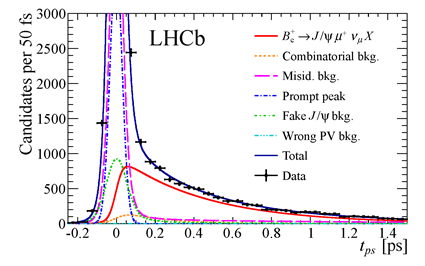[ τ( Bc+) = 509 ± 8 ± 12 fs ]
In the Standard Model of Particle Physics the strongly interacting particles (hadrons) are composed of three quarks (baryons) or quark-antiquark pairs (mesons). There are six types of quarks, three light: up (u), down (d) and strange (s) and three heavy: charm (c), beauty (b) and top (t). The top quark decays so fast that it cannot form bound particle states with other quarks. The heaviest quark which can form baryons or mesons with other quarks is the beauty quark, about five times heavier than proton. The particle physics theory predicts that the lifetime of particles made of the beauty quark and light quarks should be almost identical. The earlier experimental results were not supporting this prediction. Recently the LHCb Collaboration has shown, by measuring precisely the Λb lifetime, that indeed the theoretical predictions are correct, see 15 July 2013 news for details.
But what about the lifetime of particles composed of two heavy quarks? The LHCb Collaboration submitted today for publication a result of lifetime measurement of the Bc+ meson, formed of a b and a c quark. The lifetime of the Bc+ meson is measured using semileptonic decays having a J/ψ meson and a muon in the final state. The J/ψ mesons decay in turn into a pair of muons. The measured lifetime is 509 ± 8 ± 12 fs with an uncertainty less than half of that of the combination of results of previous measurements. This lifetime is much shorter than the lifetime of particles composed of a beauty quark and lighter quarks and closer to the lifetime of charmed particles formed by a charm quark and lighter quarks. This precise result is also very interesting for theorists studying decays of this kind of particles. The calculations are challenging since the effects of both strong and weak interactions need to be taken into account.
The image on the left shows the lifetime distribution of the Bc+ candidates, with the fitted components indicated. The analysis is performed on a data sample of pp collisions at a centre-of-mass energy of 8 TeV, collected during 2012 and corresponding to an integrated luminosity of 2 fb-1. Further improvements are expected from the LHCb experiment using Bc+ → J/ψπ+ decays, where systematic uncertainties are expected to be largely uncorrelated with those affecting the present determination.
Read more in the LHCb publication and in the CERN Courier article.
click the image for higher resolution

